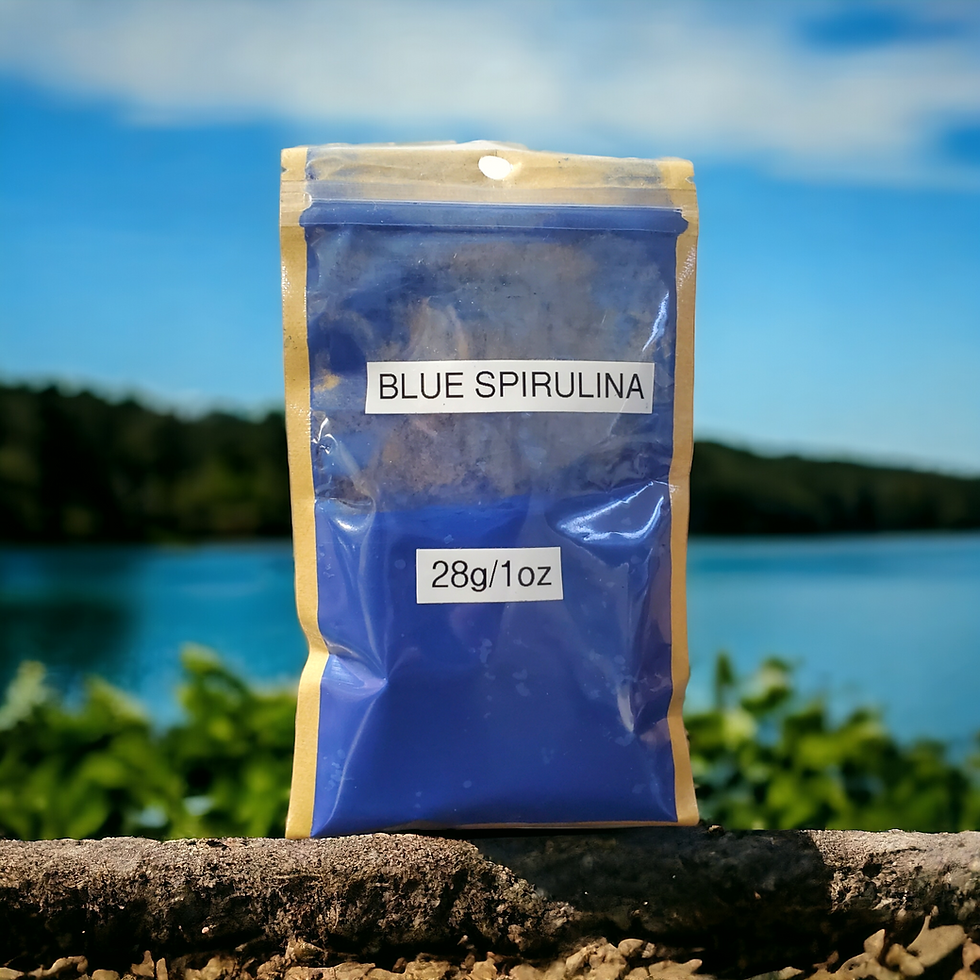BLUE SPIRULINA
Spirulina is a type of cyanobacteria — often referred to as blue-green algae — that is HIGHLY nutritious. It is considered to be a SUPERFOOD.
Studies show that it is used too boost level of nutrients and antioxidants in their bodies and it protects against various diseases.
PACKED WITH NUTRIENTS
Blue spirulina contains a variety of nutrients and vitamins in its plant-like structure. It contains nutrients like iron, protein, calcium, magnesium, and more. Additionally, spirulina provides vitamins B1, B2, and B3, as well as amino acids and Omega 3 and 6 fatty acids.
CONTAINS ANTIOXIDANT PROPERTIES
A major component of blue spirulina is the antioxidant called phycocyanin. Phycocyanin is a plant-based protein that gives spirulina its blue-green color. Phycocyanin mainly blocks inflammation and fights free radicals, a type of molecule in the body that causes damage through oxidation.
SHOWN TO LOWER CHOLESTEROL LEVELS
A study on the effects of spirulina on cholesterol levels showed that it significantly reduced LDL cholesterol and triglycerides. At the same time, spirulina was also shown to increase the levels of HDL cholesterol, also known as “good” cholesterol.
REDUCES RISK OF OXIDATION
As stated before, blue spirulina fights free radicals and reduces oxidation. However, it also reduces the occurrence of lipid peroxidation, a complex chain reaction that causes lipid molecules to damage DNA.
Oxidation in the body contributes to the development of serious diseases, such as heart disease and cancer.
REDUCES BLOOD PRESSURE WITH NITRIC OXIDE
Blue spirulina has also been shown in five studies to reduce blood pressure levels. This further reduces the risk of hypertension as well as other blood pressure-related complications.
The studies hypothesize that blue spirulina contributes to the increased production of nitric oxide. Nitric oxide is a free radical compound that takes the form of a gas. However, this type of free radical is beneficial because it supports several biological systems, including your circulatory system.
ABILITY TO PREVENT EYE DISEASES
Aside from the presence of omega-3 fatty acids, which are beneficial for eye health, blue spirulina also contains zeaxanthin. Zeaxanthin is an organic pigment integral to the composition of the eye, as it protects your vision from sun damage. Increasing your zeaxanthin intake can reduce the risk of developing certain eye diseases such as cataracts.
IMPROVED RESPONSES TO ENVIRONMENTAL ALLERGIES
Blue spirulina may help reduce the inflamed, stuffy nose symptoms that come with everyday allergies. This is due to the anti-inflammatory properties it contains. It may even be more effective than certain antihistamines we use to combat allergies.
HELPS MOOD DISORDERS
Spirulina contains the tryptophan amino acid, which triggers an increased production of serotonin. Many mental health disorders are characterized by decreased levels of serotonin. Blue spirulina might be beneficial as a supplemental treatment if it significantly increases levels of serotonin.
CONTRIBUTES TO ENDURANCE
Spirulina is hypothesized to help increase your muscle strength capacity. This is due to the work of antioxidants that prevent exercise-induced oxidation damage that causes muscle fatigue.
MANAGES BLOOD SUGAR LEVELS
Studies show promising results that spirulina manages and even lower human blood sugar levels.
POTENTIALLY EFFECTIVE AGAINST ANEMIA
In a study involving senior citizens, blue spirulina was shown to counteract anemia and have great nutritional value. This is because blue spirulina contains a good amount of iron. Though further research is necessary, it makes sense that blue spirulina could be a good supplement for anemia.
Spirulina was consumed by ANCIENT AZTECS but later became popular again when NASA proposed that it could be grown in space for use by ASTRONAUTS.
DIFFERENCE BETWEEN GREEN AND BLUE?!
The difference between regular spirulina and blue spirulina comes down to a single pigment-protein complex known as phycocyanin. Phycocyanin is a powerful antioxidant that gives blue spirulina its signature blue hue as well as several additional nutritional benefits.
Regular spirulina is a whole-cell algae from which the phycocyanin is completely extracted. As a result, it has a green color. While it is the most easily harvested form of spirulina, its health benefits are not as extensive, and its taste is less palatable, with many finding it to have an unsavory fishy quality that makes it difficult to add to juices, smoothies and breakfast bowls.
top of page

$60.00Price
bottom of page

